Lenovo Yoga 3 Pro Review: Refreshed With Faster Core M
by Brett Howse on March 13, 2015 8:00 AM ESTGPU Performance
The Core M processor has a similar GPU to the new Broadwell-U series. The Core M-5Y71 has the HD 5300 GPU, which has 24 EUs (up from 20 on Haswell-U HD 4400) and has a clock speed of 300-900 MHz. This is actually the same number of EUs and frequency as the i5-5200U that we tested in the XPS 13, but of course in a 4.5 watt TDP rather than 15 watts like Broadwell-U. We have already seen that CPU performance is very good on Core M, but GPUs can draw quite a bit of power when pushed to the limit, so we will see how it compares. First up, we can take a look at performance in some synthetic benchmarks starting with Futuremark’s 3DMark.



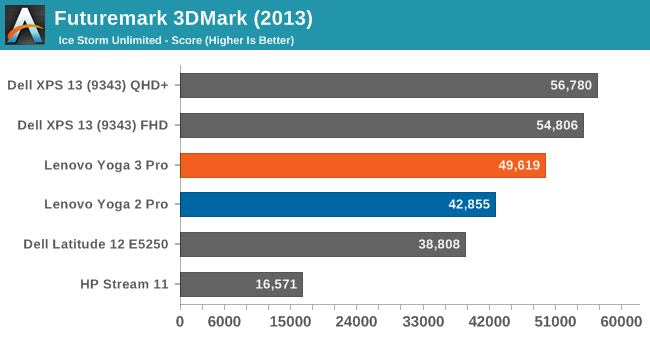
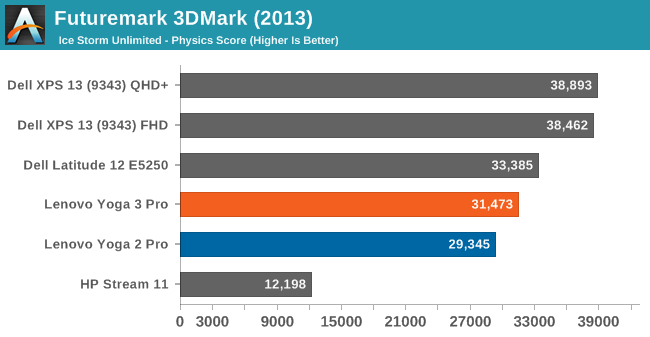
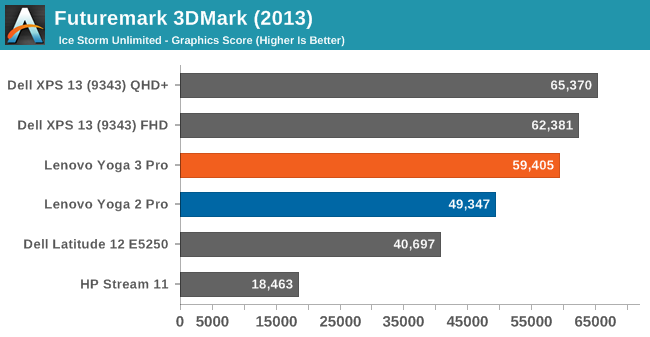
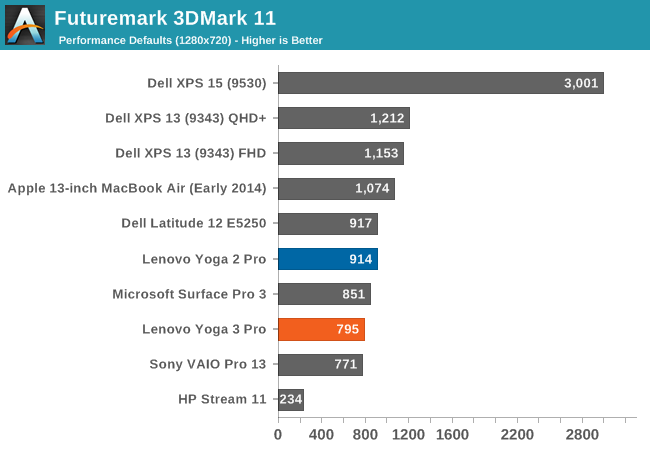
Unlike the CPU, the GPU runs out of headroom much quicker. On any of the sustained benchmarks, the Yoga 3 Pro scores significantly down on both the Haswell-U and Broadwell-U GPUs. Ice Storm Unlimited is the outlier, since it is such a short benchmark. The Core M does improve on Haswell-U in this benchmark. However compared to the HP Stream 11 which has the Atom 5 watt processor, Core M is way ahead here. Intel will be releasing a new Atom this year, and it really cannot come soon enough. Silvermont was a big improvement for Atom, but it is way behind Core M in terms of performance.
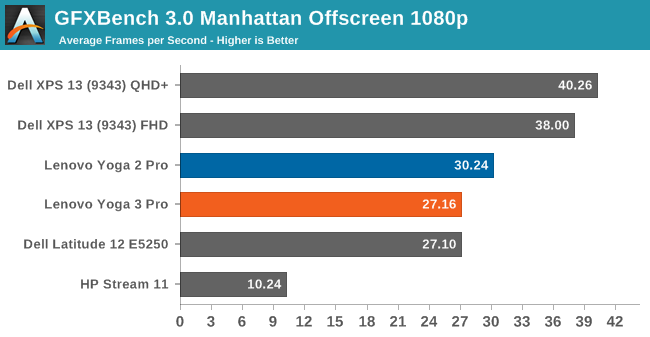

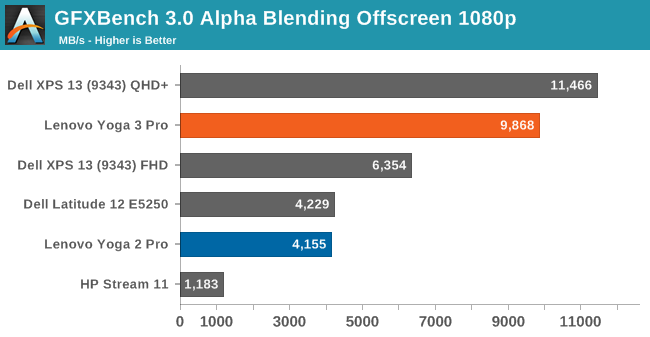
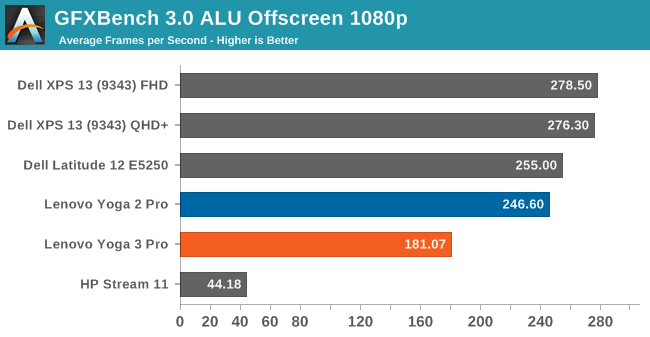

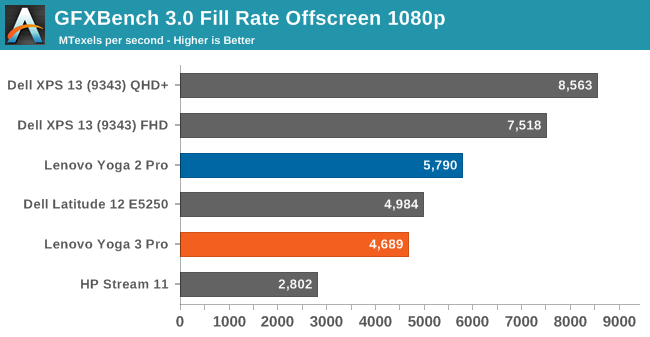

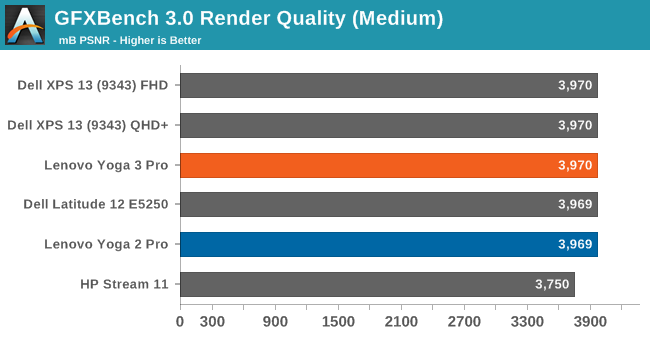
On GFXBench, we see a similar story. The 4.5 watt envelope for Core M restricts the GPU performance quite a bit, and it falls behind all of the other devices except Atom, where it destroys it. The exceptions are Driver Overhead and Alpha Blending, where newer drivers and the architectural changes of the Gen 8 graphics allow the Yoga 3 Pro to pull ahead of the Yoga 2 Pro.

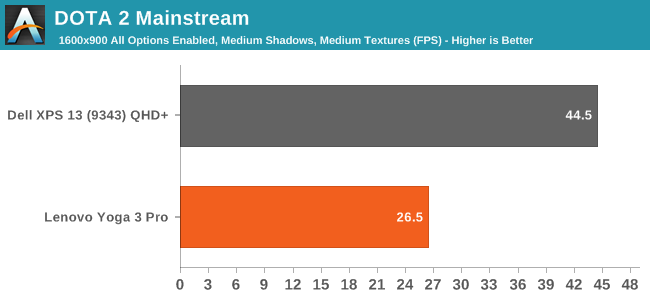
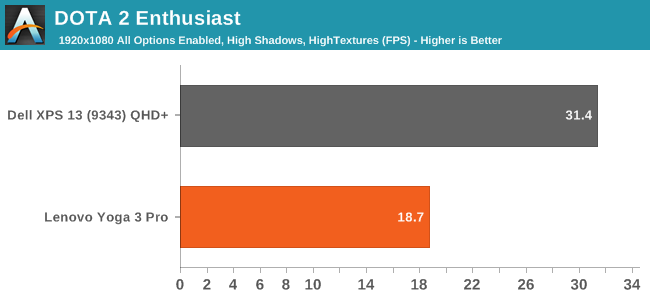
Our final GPU benchmark for Ultrabooks is our new Dota 2 Bench. We only have a single comparison at this point. The Dell XPS 13 has Broadwell-U with HD 5500 graphics. Even though both have the same number of EUs and frequencies available, it is clear the 15 watt part has a lot more headroom to allow the GPU to keep the frequency up. On Dota 2, the Yoga 3 Pro is really only playable on the Value settings, whereas the XPS 13 is over 30 FPS even on the Enthusiast settings.
For the CPU performance, Core M shows that it has the legs to compete against Haswell-U, but on the GPU side of the fence it is a different story. Core M hits the TDP limit much quicker and performance takes a nose dive. Intel still has quite a bit of work left to do on the GPU side.
Even though this is not a pure tablet, it can be used in tablet mode, so we can compare it to those devices as well.
Tablet Comparison
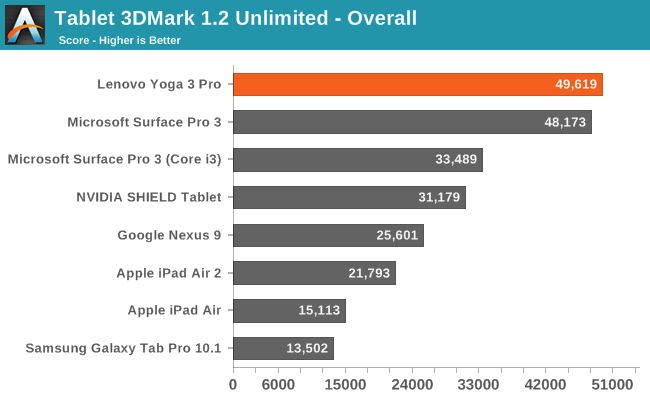
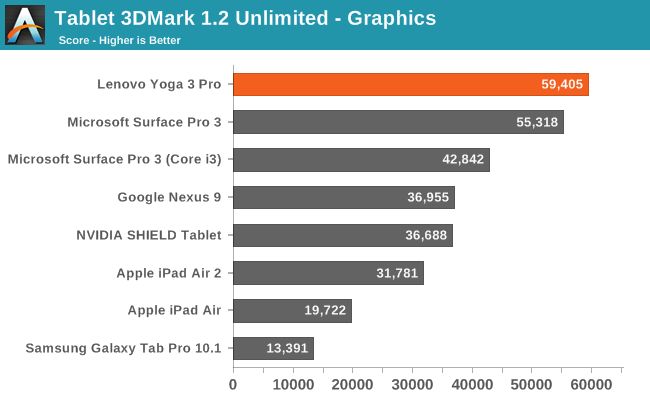

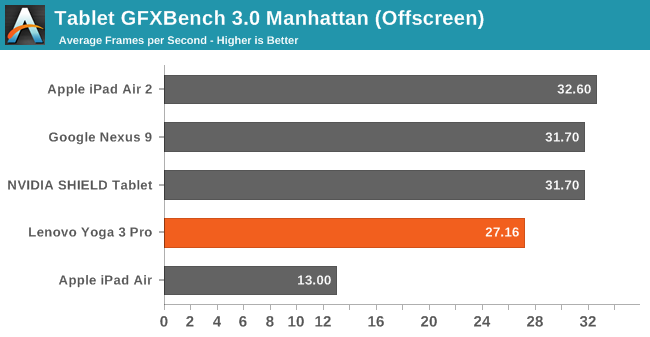

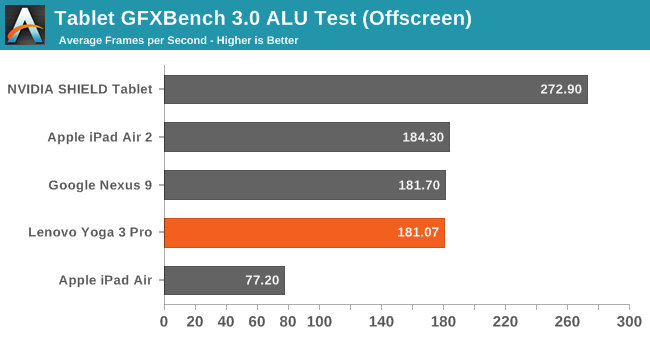
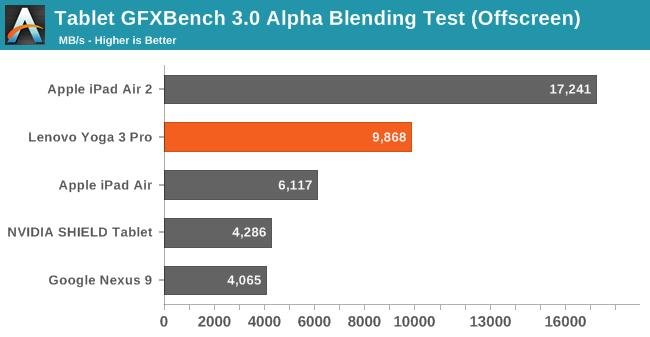

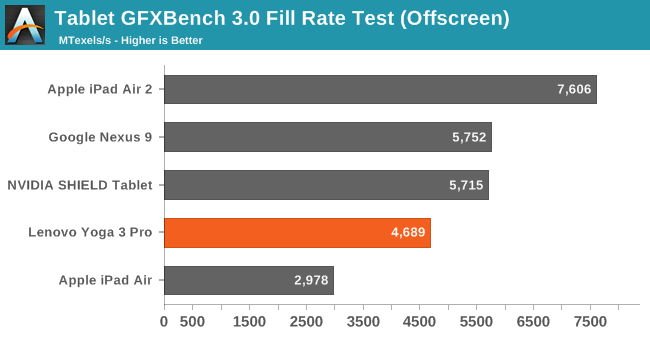
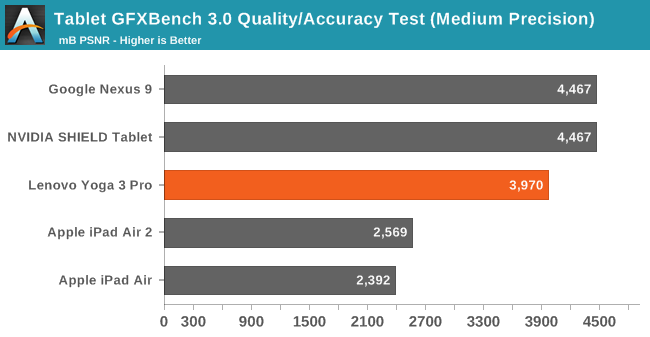
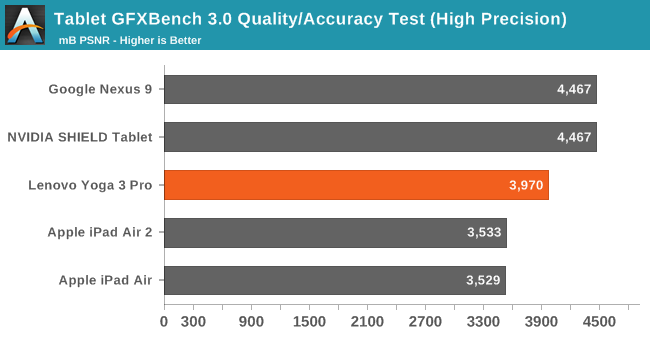
The typical tablet SoC will be very similar to the Core M processor as far as TDP. Though none of the tablets will advertise TDP, under load it is going to be fairly close to 5 watts or so. Some of the higher performance tablets may even pull a bit more power. We see some different results looking at the different benchmarks. 3DMark is very much a win for Core M’s GPU, but the benchmark is very short. It shows the potential for the HD 5300, but on any sustained workloads it bumps into the TDP fairly quickly and the scores go down.
Of note from the 3DMarks scores though is the Physics score, which is a CPU score. Core M has quite a jump in performance compared to the average Tablet SoC. This also is obvious when you compare the web tests between the Core M and a tablet. For instance, the Apple iPad Air 2 scores 4014.3 in Kraken, and the Yoga 3 Pro scores 1729.7 (lower is better – it is a score in milliseconds). WebXPRT is 1728 on the Yoga 3 Pro, but the iPad Air 2 only scores 688 (higher is better) and A8X has three CPUs versus two in Core M. Apple has been touted as having one of the best SoC CPUs, but they are no match for Intel in this arena.
The GPU side is not as rosy though, with the GFXBench scores placing HD 5300 well behind the top tablet GPUs of today. The performance potential is there for HD 5300, but it needs more TDP to exploit it with the current architecture. This is an area where Intel has been upgrading every single year, but the GPU being integrated into the CPU means that GPU updates have to wait for new product launches.










113 Comments
View All Comments
Brett Howse - Friday, March 13, 2015 - link
Sorry corrected the TDP info. We can debate about whether it is an Atom or Celeron, but it's really an Atom rebadged.jhoff80 - Friday, March 13, 2015 - link
I think you missed one. "The 5 watt Atom core in the HP Stream is sorely outclassed by the 4.5 watt Core M."kepstin - Friday, March 13, 2015 - link
Not sure what you're saying here... Bay Trail is the latest evolution of Intel's Atom series of processor core designs. While they're not using the Atom brand for it any more, that's still pretty much what it is.azazel1024 - Friday, March 13, 2015 - link
But the point is, it isn't the atom brand. It is the same architecture, but compared to the actual TABLET chips, in some ways it is worse. You have higher TDP, but the CPU is actually worse in a lot of ways, especially multithreaded tests. You've got 2 cores at up to 2.58GHz, where as the top end Atom Bay Trail chips you have 4 cores at up to 2.39GHz. I can attest in long work loads in passively cooled tablets, the z3775 doesn't really seem to throttle...so you have potentially close to a doubling of performance in highly threaded workloads for something like the z3775 compared to the N2840...which makes the whole CPU performance inbalance between "Atom" and "Broadwell M" a heck of a lot less than these tests make it out to be.Oh...there still is, but in highly threaded work loads the inbalance isn't all that much.
On the GPU side of things...well N2840 or z3775 (or other Atom chip), Broadwell M still crushes it.
It'll be interesting to see how the top end Atom Cherry Trail chips stack up. Assuming ZERO IPC improvements (and I assume there will be at least a little), it clocks in ~200MHz faster than Bay Trail and 4x the EUs (Intel was claiming top clocks of 2.6GHz and 16EU for the top end Cherry Trail tablet chips). The current pre-release Intel claims of ~100% faster GPU with no CPU claims right now.
Still makes Cherry Trail a fair amount slower on the GPU side of things, but on the CPU side...that puts it spitting distance with Broadwell M for multithreaded and if there are modest IPC improvements it might actually actually be FASTER in some multithreaded workloads.
extide - Friday, March 13, 2015 - link
It's not hard to imagine a quad core beating a dual core in multi threaded... Remember though, that in normal use, the feeling of it being fast or slow is all about single threaded speed.Also, don't get all confused with the brand names. There are 2 cores, the Atom core and the 'Core' big core -- it doesnt matter whatever brand name they use it is still either Intel's big core or little core.
fokka - Friday, March 13, 2015 - link
i think you are reading too much into the branding. it's still atom, which still means somewhat poor single threading, poor graphics, but quite ok multi threading, since there often are four cores instead of the two cores you get in all of intels other sub-35w mobile parts.i think intel doesn't do itself a favour spreading the celeron and pentium brands to the atom architecture, but here we have it, let's not make it any worse.
Solandri - Friday, March 13, 2015 - link
Intel's marketing division is just trying to confuse people by extending the Celeron and Pentium names to CPUs with the Silvermont architecture, so they can sell computers with cheaper parts for more money.Most people use the term "Atom" to refer to Intel's (current) Silvermont architecture used in Atom, and now some Celeron and Pentium models. As opposed to Intel's Haswell cores (used in Haswell and Broadwell) used in their i3/i5/i7, as well as some of the Celeron and Pentium models.
Since historically the Celeron name was only given to the upper tier architecture (Haswell, Sandy Bridge, Nehalem), it's more accurate to call the N2840 an Atom than a Celeron. Calling the N2840 a Celeron is kinda like calling the 4-cylinder Mustang a Mustang. The performance just isn't there to back up the name.
mkozakewich - Saturday, March 14, 2015 - link
Doesn't "Mustang" mean performance, though? If you get a Celeron computer, you're expecting something cheap and just fast enough to use for basic tasks.extide - Friday, March 13, 2015 - link
...Which means it's an Atom.jabber - Friday, March 13, 2015 - link
First thing I'd do if that was mine? Get rid of those awful stickers.Like those dumb car parts shopping lists muppets stick on their mom's Civic.